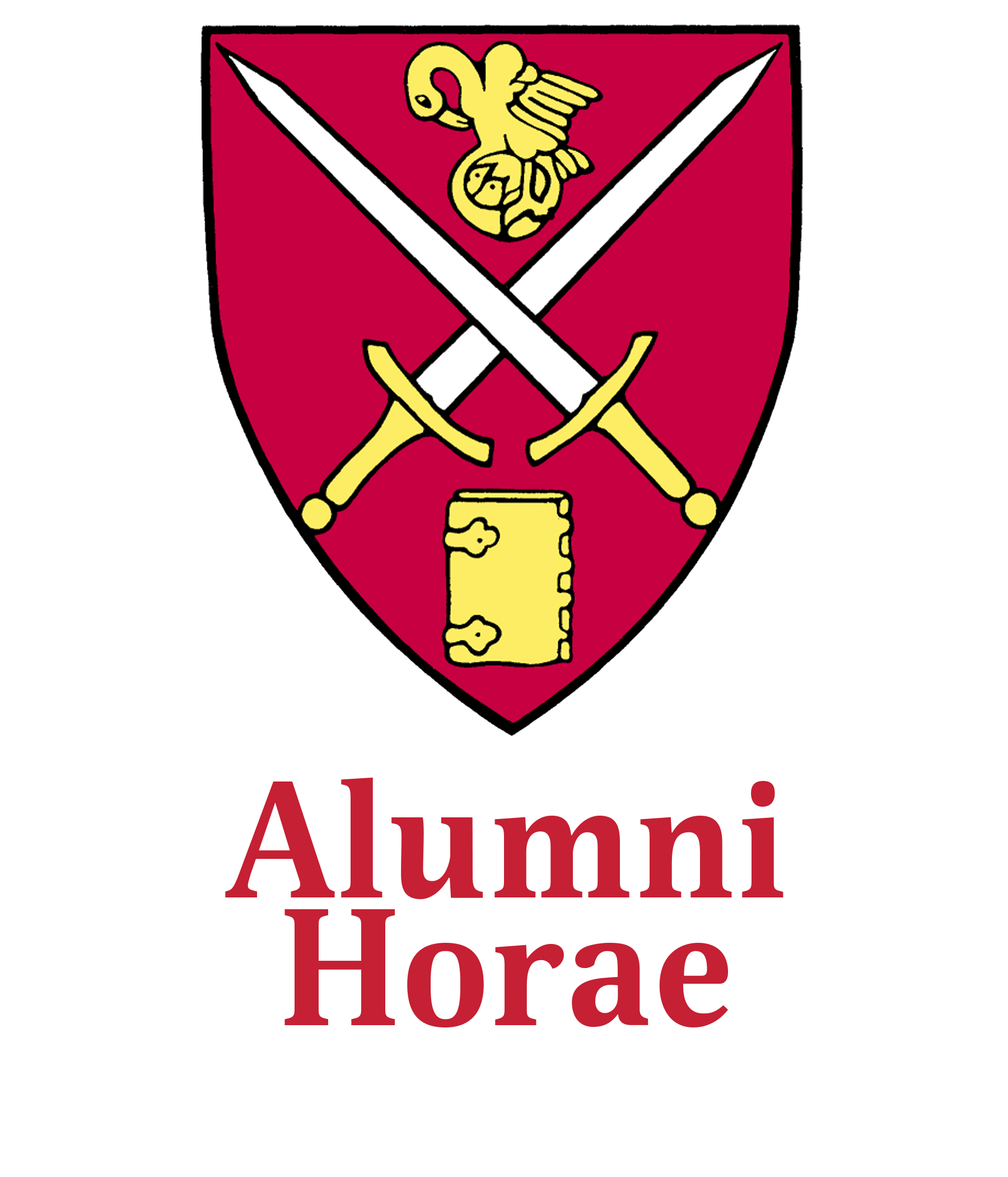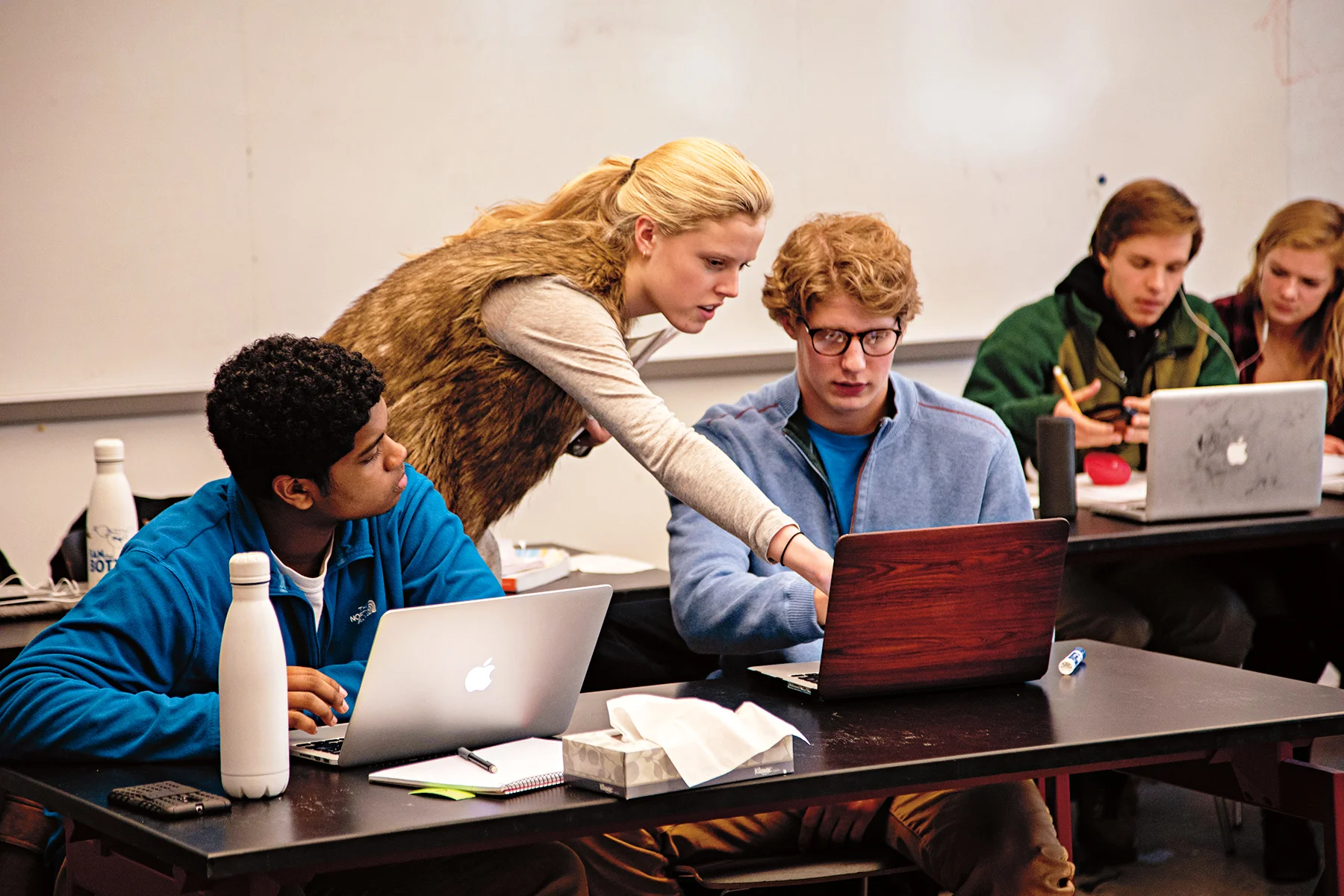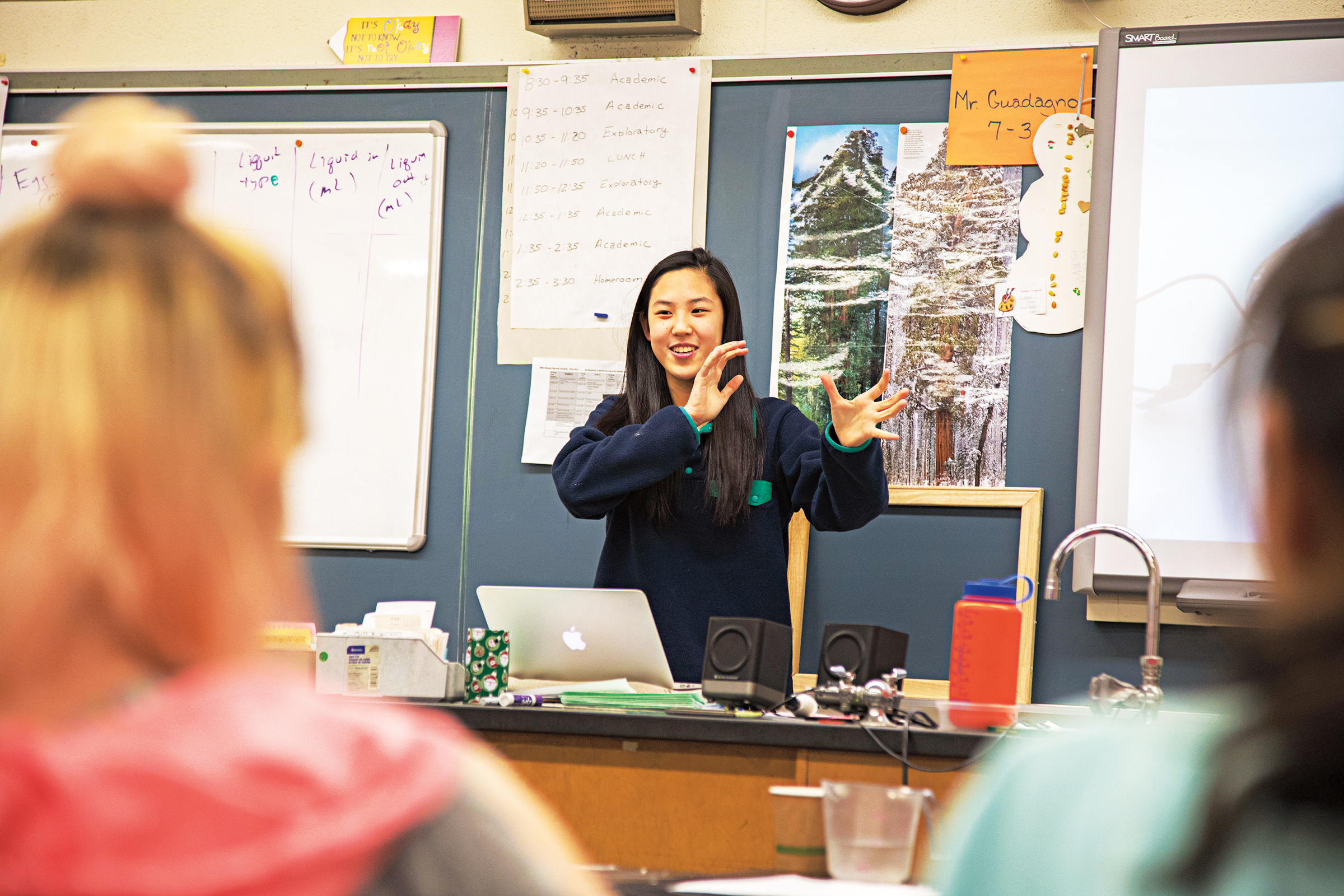SPS Today
Arts Renovations Underway
Expanded studio spaces in the converted Moore Building, which for years housed the School’s mathematics program, will allow additional fine arts course offerings for the 2017-18 academic year and beyond. The newly renovated fine arts building, along with a 1,550-square-foot addition, is expected to open in the fall of 2017. It will include a 2D area on the upper level, with spacious painting, printmaking, architecture, drawing, and design studios housed in an open, flexible arts loft. The 3D program, located on the lower level, will be expanded to include large ceramics, sculpting, and welding studios and a glass workshop. Metal welding and glass blowing are two new mediums made possible by the renovated building.
Following the Moore renovation, work will begin on transforming the current Freeman Student Center for fall 2018 into the new Crumpacker Gallery, with climate-controlled exhibit and storage spaces. The upper level of Crumpacker will feature a modern exhibit space, while the lower level will include an art storage area and a digital photography center. Through four major shows a year, the Gallery will display artists’ works and also host annual faculty and student shows for public viewing. The Crumpacker Gallery also will be a teaching gallery, with exhibitions timed to coincide with art courses in related subjects. Following tradition, exhibiting artists supported by endowed funds, such as the Catherine Taylor Visiting Artists Fund, will be invited to interact with students in the classroom setting. The lower level of the converted Freeman building will house the School’s permanent teaching collection. It also will be home to two photography studios, allowing students to explore the medium of photography through film, digital, and computer-based techniques.
When Worlds Collide| New Class Mimics Nature Through Technology
Sixth Formers (l. to r.) Rishaun Noel-Maikoo, Noelle DesLauriers, and Karl Risley collab-orate on a nautilus-inspired redesign for the greenhouse inside the Lindsay Center.
Art, engineering, and science have come together in a new interdisciplinary class. The Winter Term Biomimetics in Engineering and Architecture course challenged students to make connections between natural and manmade problems and find efficient solutions. Biomimetics, in which technology is inspired by imitating proven elements of nature, is experiencing a resurgence, but is not a new concept; Leonardo da Vinci studied nature to inform his flying machine sketches, for example. Science faculty member Steffen Poltak first encountered the concept as a postdoctoral fellow at Harvard Medical School. There, he became acquainted with Harvard’s Wyss Institute for Biologically Inspired Engineering.
Using the School’s engineering, art, and science resources, including 3D printing capabilities, Poltak asked his students to craft an installation or architectural structure to benefit an urban area in need of renovation. “For 3.8 million years, life has been on this planet and the environment has selected it,” says Poltak. “We are mimicking millions of years of research and development of those things that are now known to work for our benefit. The [students] are going into the creative process with a new lens.”
Kat Ramos ’17 and Brianna Hill ’18 designed a city community center. The layered growth of oyster mushrooms and their natural slope provided the girls with an idea to collect rain water for a sustainable greywater system. The School plans to offer Biomimetics again next winter.
Gabriel Patenotte ’17 used a 3D printer to form a model of a floating solar panel inspired by the Victoria water lily pad, which is known as a strong plant. Patenotte’s goal was to use the lily pad as a flotation device. He did that by mimicking the plant’s roots and using its ability to capture oxygen to make it float. “If it were to submerge itself in a rough sea,” he explains, “it would rise back up.”
Languages| Fifth Former Nabs Top Honors in Chinese Speech Contest
Five months of study and dedication led to three minutes of academic glory for Rowan Macy ’18. At the 12th Chinese Bridge Speech Contest, held at the University of Massachusetts Boston in April, the New Hampshire native recited a memorized speech in Chinese and left as the victor in the beginner category. “Five months is a really big commitment,” says Macy’s Chinese 2 Honors teacher and coach Zhaohong Jenny Li. “This was driven by her.” Recognized for her proficiency and pronunciation, Macy was among 75 students from 19 states and 48 high schools in the competition. After acing the preliminary round, which required participants to record their speeches and be judged on pronunciation, she became one of 24 finalists.
Friendship inspired Macy to pursue Chinese language study. An exchange program at her previous high school introduced her to a classmate from China who had studied English for 10 years and was close to fluency. Her dedication inspired Macy to strive for foreign
language fluency when she entered SPS. “There are so many people who speak Mandarin,” says Macy. “If it is a language I can master, it opens doors to being able to talk to new people and learn about them, which is something I really care about.”
Another appeal of studying Chinese for Macy is its sharp contrast to Western linguistics. Chinese is a language with four distinct tones. As students learn, there can be as many as 20 variations on one word, but correct pronunciation is just the start of comprehending the language. In print, Chinese has 5,000 characters, though Li says a grasp of 1,000 characters is enough for a person to be able to read the newspaper. “It’s kind of like a puzzle,” says Macy. “Chinese doesn’t have a lot of rigid grammar structure in the way a romance language does. There are a lot more things implied by context.”
Relay for Life| Cancer Awareness Society Students Step Up
In February, the American Cancer Society (ACS) recognized the St. Paul’s School Relay for Life team as its top fundraising high school in the country. Scores of handwritten letters, social media posts, and personal outreach resulted in the student-organized event, held on April 29 in the Matthes Cage. Relay for Life at SPS was the brainchild of Cancer Awareness Society co-heads Max Drinon ’17 and Meg Fearey ’17, who led more than 50 of their peers in a yearlong fundraising campaign to benefit the ACS. The two began planning the fund drive last spring, and their efforts paid off. In total, the group raised more than $40,000, surpassing its initial goal of $16,000.
April’s School-wide event marked the culmination of many months of hard work for Drinon and Fearey. The evening featured remarks by Dr. Otis W. Brawley, chief medical officer of the ACS, and also included a walk around the School’s indoor track by survivors and caregivers. “The passion and personal connection Max and Meg have brought to the project have enabled them to tap into the School community,” said their adviser, Laura Hrasky.
Before coordinating with Drinon on Relay for Life, Fearey raised $7,000 for the Making Strides Against Breast Cancer walk in Concord. Their shared mission was personal for both Drinon and Fearey. Drinon is a cancer survivor and Fearey’s family has coped with multiple diagnoses in close succession. The money raised through Relay for Life will be used by the ACS to fund research and patient services, including rides to and from treatment and doctor’s appointments, along with volunteers to offer support. Drinon was diagnosed in the fall of 2014. After two surgeries and four rounds of chemotherapy, he is cancer-free and will play football for Bentley College in Waltham, Mass., this fall. “This [funding] helps people who are in the situation I was in,” says Drinon. “I was lucky that my mom was there to give me anti-nausea medicine in the middle of the night when I was too tired to get up and take it. It helps to be somewhere familiar with someone who cares.”
Girls in Science| Students Mentor Local Middle School Girls
Through the Community Outreach Program, SPS students, including Jackie Shen-Yi ’20 (below), are transported weekly to Concord’s Rundlett Middle School to engage with local girls in the Girls for Engineering, Math, and Science (GEMS) program. GEMS is part of a national movement that promotes the mentorship of girls in Science, Technology, Engineering, and Math (STEM).
Library News| Visiting Authors Series
Terry Farish’s The Good Braider (2012), is based on real-life interactions with female refugees from South Sudan acclimating to life in Portland, Maine. The novel’s themes were particularly relevant during her February 16 visit to a Humanities IV class, as President Trump’s executive order on immigration brought the conversation to the forefront. “I know what it feels like to leave home and to leave the culture you grew up with,” said Brazil native Estela Lacombe Franca ’19. “The book is very important, especially now.”
Farish visited SPS through Ohrstrom Library’s new Visiting Authors Series. So far, the SPS community has interacted with several writers at the School and in Downtown Concord. When Lacombe Franca and her formmates read the book before Farish’s visit, their teacher, The Rev. Alice Courtright, deliberately withheld information from the group; the novel’s narrator is a teenage refugee of color, but the author is a white woman. The revelation brought a new layer to the discussion, challenging students and Farish in a talk about the dynamics of privilege. As Farish came to know the South Sudan refugee community, she felt the need to bring wider attention to their experiences. “I wrote it because I had to write it,” she said. The Visiting Authors Series is one of a growing number of programs offered through Ohrstrom Library. Among other activities, students are invited to Saturday afternoon write-ins.
Pond Hockey for a Cause| Student Initiative Drives Community Effort
Lower School Classic winners (back, l. to r.) Jake Demers ’18, Oliver Morton ’18, Ben Leach ’18; (kneeling, l. to r.) Gillis Frechette ’18 and Sam Born ’18.
Benjamin Leach ’17was at an advisee dinner when a conversation about charity sports events connected in his brain with archival photographs of some of the initial hockey teams at SPS. The concept of the School as the Cradle of American Hockey inspired in Leach the idea to organize a hockey tournament on Lower School Pond.
Proceeds from the February 19 “Lower School Classic” – including apparel sales – were earmarked for the Concord Coalition to End Homelessness. Leach’s mother teaches college-level English courses at a homeless shelter through a program at Salem State University (Mass.). Having witnessed the difficulties of life without the luxuries many of us are afforded, Leach knew he wanted to give back. The $5 entry fee per person went toward creating care packages for the homeless, which included necessities such as toothbrushes and food. Matt Stellato ’17 helped Leach design and order Lower School Classic apparel.
The bracket-based tournament ended up being forced inside the Matthews Hockey Center by a winter storm. But Leach’s efforts mobilized the School community, drawing close to 200 students, parents, and faculty as spectators and participants and selling more than 100 pieces of apparel. The Missionary Society also donated $942 in proceeds earned from T-shirt sales at the MISH dance.
Leach surpassed his original goal of $500, raising $2,200 to benefit the Concord homeless population. He hopes the tradition will continue into the future.
Faculty in Action| Mixing it Up in Humanities IV
At the start of an 80-minute class period, faculty member Matt Soule ’77 gave his Humanities IV class 10 minutes to draft their thoughts on the ending of John Steinbeck’s Cannery Row. Humanities IV is a required course that concentrates on American studies, spanning the colonial and revolutionary periods to the Civil Rights Movement of the 1960s. By the time Soule’s students read Cannery Row, they already had examined themes of inclusivity and exclusivity and the concept of the American dream in Toni Morrison’s Beloved and F. Scott Fitzgerald’s The Great Gatsby. Steinbeck’s abrupt conclusion to his Depression-era novel elicited strong reactions in class discussions.
“A primary goal of humanities courses is to get students to look at history, literature, art history, philosophy, and music, and see how the questions of one connect to another,” says Soule. The writing exercise was only the beginning of a class that incorporates the Harkness method, which means plenty of lively discussion around a table. “It’s a very safe space to share thoughts and ideas,” says Blake Letourneau ’19. “At the Harkness table, you can’t hide. You have to come prepared, but you feel more comfortable because everybody participates.” While analytical writing plays a significant role in the curriculum, Soule gives his charges the opportunity to flex creative muscle. He recently challenged students to createoriginal endingsto Cannery Row as part of a homework assignment. “We like to mix it up a bit,” he says.
Matt Soule ’77 challenges his Humanities IV class.






